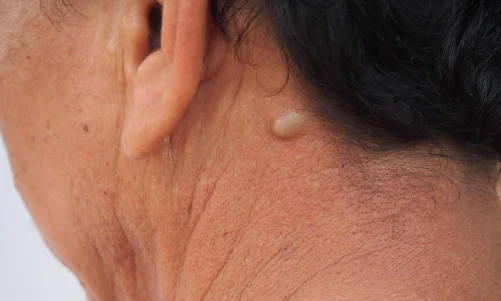A sebaceous cyst, a common benign skin condition, forms when a hair follicle gets blocked and fills with keratin. Although often harmless, complications such as infection, pain, and rupture may require treatment, ranging from antibiotics to surgical removal
If you're considering treatment for a sebaceous cyst, reach out to us or book a direct appointment with our dermatologist. At the CK Birla Hospital, we are dedicated to ensuring that your sebaceous cyst treatment is as safe, comfortable, and effective as possible. We're here to guide you every step of the way toward a successful recovery.

Sebaceous cysts are formed by your sebaceous gland, which produces the oil (sebum) that coats your hair and skin. These cysts can develop if the gland or its duct becomes damaged or blocked, often due to trauma to the area, like a scratch, surgical wound, or skin condition such as acne. The cysts grow slowly, so the triggering trauma might have occurred weeks or months before noticing the cyst. Causes of sebaceous cysts may include:
These factors contribute to the development of sebaceous cysts over time.
Untreated sebaceous cysts pose several risks, such as:
Seek medical attention for proper evaluation and treatment to avoid complications and misdiagnosis.
There are generally two main types of sebaceous cysts based on their origin and location:
Sebaceous cysts are slow-growing, painless lumps/bumps unless inflamed or infected. While generally harmless, they can be removed if bothersome or for cosmetic reasons
Cysts can be treated either by draining them or through surgical removal, often chosen for cosmetic purposes. Although generally harmless, they tend to recur without surgical intervention. Most doctors allow patients to select their preferred treatment method based on individual preferences. The treatment options are:
Post-surgery, antibiotic ointment is typically prescribed to prevent infection until healing is complete. Scar cream may also be provided to minimise surgical scars.
Sebaceous cysts are typically diagnosed through a basic physical examination by doctors. However, if the cyst appears unusual, additional tests might be requested to rule out potential cancers, particularly if surgical removal is being considered. These tests commonly employed for sebaceous cysts encompass:
Sebaceous cysts can sometimes be prevented by adopting these measures:
The cost of a sebaceous cyst treatment varies as per the specific type of treatment advised by a healthcare provider, such as: Conventional wide excision Minimal excision Laser with punch biopsy excision The cost can also vary widely depending on several factors, including the location, the extent of the treatment, the doctor’s experience, and the hospital’s pricing structure. To get an explicit estimate for the cost of a sebaceous cyst treatment at the CK Birla Hospital, contact the hospital directly. Additionally, you can consult with our board-certified dermatologist to discuss your specific needs and receive a personalised quote for the treatment.
Sebaceous cysts are typically benign and not cancerous. They are sac-like structures filled with keratin and usually develop in hair follicles. Removal may be necessary for cosmetic or discomfort reasons.
It’s not recommended to pop or squeeze a sebaceous cyst at home. This can lead to infection, pain, and recurrence. See a healthcare professional for proper evaluation and treatment.
Sebaceous cysts may persist or even grow larger without treatment. They often do not resolve on their own and typically require medical intervention such as drainage or surgical removal.